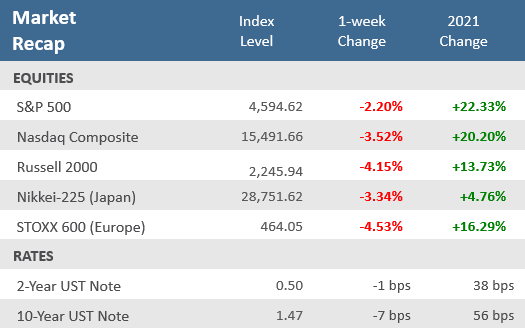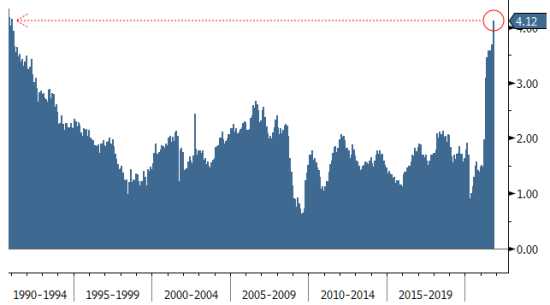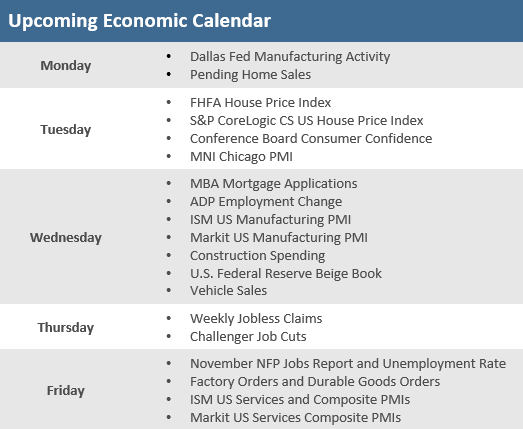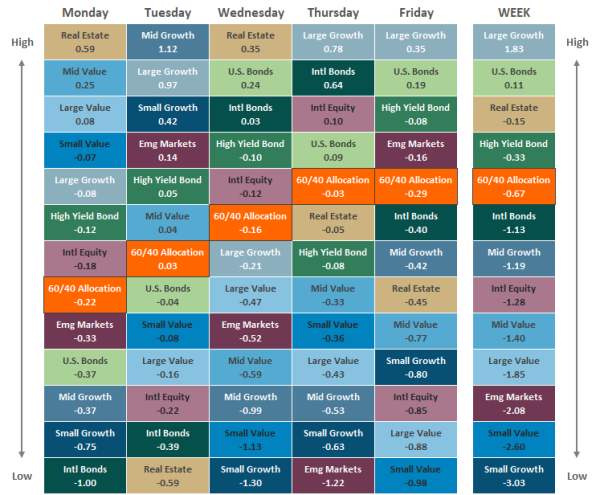Quick Takes
- Global stocks declined sharply over the week, but most remain within a few percentage points from their all-time highs. Positive economic data before Thanksgiving Day couldn’t overcome a significant decline on Friday as stocks, commodities, and bond yields plunged on news of a new coronavirus variant that emerged out of South Africa.
- The S&P 500 fell -2.2% for the week, its worst week since early October. Small-cap stocks and growth stocks were hit particularly hard. The tech-heavy Nasdaq fell -3.5%, its worst week since late February, and the small-cap Russell 2000 fell -4.1%.
- U.S. bonds were the only major asset class to gain for the week as yields dropped. The benchmark 10-year U.S. Treasury yield fell 7 basis points helping the Bloomberg Aggregate Bond Index eke out a gain of +0.13%.
New variant vexes investors despite solid economic data
The Thanksgiving holiday-shortened week began with news on Monday that President Biden would renominate Jerome Powell as the Federal Reserve chairman. Initially, stocks cheered the announcement, hitting intraday record levels, but then sold off towards the end of the day. Tech stocks, with higher valuations, were hit harder as investors considered that higher rates with Powell as Fed chair was now more likely. On Tuesday, the Biden administration announced it would release 50 million barrels of crude from the Strategic Petroleum Reserve in a coordinated effort between China and Japan and several other energy-consuming nations to combat the rapid rise in energy prices. However, the announcement had the opposite effect as oil prices rose almost immediately. The last big, coordinated international release in June 2011 saw oil prices initially dip but then move $4.66 higher per barrel within two weeks. An onslaught of economic data was released on Wednesday due to Thanksgiving and a shortened Friday session. Reports mainly were in line or better than expectations, including strong personal income and spending, solid home sales, and tight labor markets.
However, the week’s biggest headlines came on Friday’s shortened session as markets were shaken as a new COVID-19 variant emerged in South Africa. Fears of travel restrictions and perhaps additional lockdowns had investors selling virtually all risk assets. Not surprisingly, the travel and leisure industry and energy sectors were hit particularly hard. The Wall Street Journal reported that the South African strain has a high number of mutations that scientists think may make it more transmissible and able to evade some of the immune responses triggered by previous infection or vaccination. However, initial reports from medical experts in South Africa state that symptoms are mostly mild and may be treated at home.
Chart of the Week
Inflation rose strongly in October, accelerating at its fastest pace since the early 1990s, according to the Commerce Department’s latest release of the Fed’s preferred inflation gauge, the Core PCE index. Prices for Personal Consumption Expenditures excluding food and energy increased +4.1% from a year ago, its highest rate of growth since January 1991. Including food and energy, the PCE index rose +5%, the fastest gain since November 1990. The upward revisions for the past month suggest inflation is running hotter than realized. Bloomberg economists expect inflation to further accelerate into early next year. Household spending is also surprisingly robust. The combination of higher inflation risks and consumer resiliency means that the likelihood of the Fed accelerating the pace of taper has increased.
Fed’s Favorite Inflation Indicator At 30-Year High
Core PCE is the highest since January 1991
Source: Bloomberg.
Economic Review
- Existing Home Sales jumped +0.8% in October to an annual pace of 6.34 million homes, above Bloomberg expectations for 6.20 million and September’s unrevised 6.29 units. The median existing-home price was up 13.1% from a year ago to $353,900, marking the 116th straight month of year-over-year gains. There were 1.25 million homes available for sale at the end of October, which is 12% lower compared with a year ago.
- New Home Sales rose +0.4% in October to an annual rate of 745,000 units, underestimates for 800,000 and September’s negatively-revised 742,000. The median home price jumped +17.5% from last year to $407,700. New home inventory rose to 6.3 months from September’s 6.1 months. New home sales are based on contract signings, offering a timelier read on housing activity compared to the larger contributor of existing home sales, which are based on closings.
- The second estimate of three for Q3-2021 Gross Domestic Product (GDP) showed a quarter-over-quarter annualized rate of growth of +2.1%, revised up from the first estimate of +2.0%, a bit below expectations for an upwardly revised +2.2%. Q2’s figure remained unrevised at +6.7%. Personal Consumption was revised to a +1.7% increase, versus expectations of an unrevised +1.6%.
- The Chicago Fed National Activity Index, which draws on 85 economic indicators, was +0.76 in October versus -0.18 in September showing a big improvement in US economic activity ahead of the winter holidays. Employment-related indicators contributed +0.24 to the CFNAI, up from +0.16 in September, and production-related indicators contributed +0.44, up from –0.35 in September. 61 of the 85 individual indicators made positive contributions.
- The Richmond Fed Manufacturing Activity Index slipped to 11 from 12 in October, in line with expectations. New order volume dipped but remained in expansion territory.
- The November preliminary Markit U.S. Manufacturing PMI Index rose to 59.1 from 58.4 in October, in line with the expectations and still solidly in expansion territory (readings above 50). However, the preliminary Markit U.S. Services PMI Index unexpectedly decelerated, sliding to 57.0 from 58.7 in October (forecasts were for an increase to 59.0). Markit said the composite index from both sectors shows the U.S. economy continues to run hot, but also mentioned that the slid in services shows how the economy is struggling to cope with supply constraints.
- October preliminary Durable Goods Orders fell -0.5%, versus estimates of +0.2% and September’s downwardly revised -0.4% decline. Ex-transportation, orders were up +0.5%, in line with estimates but below September’s upwardly revised +0.7% rise. Orders for non-defense capital goods excluding aircraft, considered a proxy for business spending, increased +0.6%.
- Personal Income rose +0.5% in October, above forecasts for +0.2% and September’s unrevised -1.0% drop. Personal Spending rose +1.3%, above estimates of +1.0% and September’s unadjusted +0.6% increase. The October Savings Rate as a percentage of disposable income was 7.3%.
- The final November University of Michigan Consumer Sentiment Index was revised up to 67.4, versus expectations for 66.9 and the preliminary reading of 66.8, but was lower than October’s 71.7 level, as sentiment regarding both expectations and current conditions fell.
- Weekly unemployment claims fell to 199,000, far below estimates of 260,000 and the prior week’s 268,000. That marks the lowest level since 1969. Continuing claims fell by 60,000 to 2,049,000, which was a new pandemic low.
The Week Ahead
The economic calendar is fairly busy in the upcoming week with Purchase Managers Indices (PMIs) from the ISM and Markit, Home Price Indices (HPIs) from FHFA and S&P CoreLogic, consumer confidence, and vehicle sales, but the big headlines will probably be from the November nonfarm payroll report on Friday.
Did You Know?
WHEN THE FED LAST RAISED RATES — Between 12/14/16 and 12/19/18, the Fed raised short-term interest rates 8 times (0.25 percentage points each time) and over that period the S&P 500 increased +15.8% (total return including dividends) in aggregate over the 2-years (source: BTN Research).
HAVE TO MOVE QUICKLY — For the 12 months ending 6/30/21, US homes for sale were on the market for a median period of just 7 days before going under contract. That’s the shortest period recorded nationwide in data that has been tracked since 1989 or more than 3 decades (source: National Association of Realtors, BTN Research).
WHAT HAS CHANGED? — Through Sept. 30, central banks around the world have raised interest rates 63 times versus just seven rate cuts in 2021. That compares with 199 cuts against nine increases in 2020 (source: T. Rowe Price, The Wall Street Journal).
This Week in History
This week in 1990, the Shanghai Securities Exchange was re-established in China, 31 years after it was closed by the new Communist regime (Source: The Wall Street Journal).
Asset Class Performance
The Importance of Diversification. Diversification mitigates the risk of relying on any single investment and offers a host of long-term benefits, such as lowering portfolio volatility, improving risk-adjusted returns, and helping investments to compound more effectively.
Source: Bloomberg. Asset‐class performance is presented by using market returns from an exchange‐traded fund (ETF) proxy that best represents its respective broad asset class. Returns shown are net of fund fees for and do not necessarily represent the performance of specific mutual funds and/or exchange-traded funds recommended by The Retirement Planning Group. The performance of those funds may be substantially different than the performance of the broad asset classes and to proxy ETFs represented here. U.S. Bonds (iShares Core U.S. Aggregate Bond ETF); High‐Yield Bond (iShares iBoxx $ High Yield Corporate Bond ETF); Intl Bonds (SPDR® Bloomberg Barclays International Corporate Bond ETF); Large Growth (iShares Russell 1000 Growth ETF); Large Value (iShares Russell 1000 Value ETF); Mid Growth (iShares Russell Mid-Cap Growth ETF); Mid Value (iShares Russell Mid-Cap Value ETF); Small Growth (iShares Russell 2000 Growth ETF); Small Value (iShares Russell 2000 Value ETF); Intl Equity (iShares MSCI EAFE ETF); Emg Markets (iShares MSCI Emerging Markets ETF); and Real Estate (iShares U.S. Real Estate ETF). The return displayed as “Allocation” is a weighted average of the ETF proxies shown as represented by: 30% U.S. Bonds, 5% International Bonds, 5% High Yield Bonds, 10% Large Growth, 10% Large Value, 4% Mid Growth, 4% Mid Value, 2% Small Growth, 2% Small Value, 18% International Stock, 7% Emerging Markets, 3% Real Estate.
Chris Bouffard is CIO of The Retirement Planning Group (TRPG), a Registered Investment Adviser. He has oversight of investments for the advisory services offered through TRPG.
Disclaimer: Information provided is for educational purposes only and does not constitute investment, legal or tax advice. All examples are hypothetical and for illustrative purposes only. Past performance of any market results is no assurance of future performance. The information contained herein has been obtained from sources deemed reliable but is not guaranteed. Please contact TRPG for more complete information based on your personal circumstances and to obtain personal individual investment advice.





